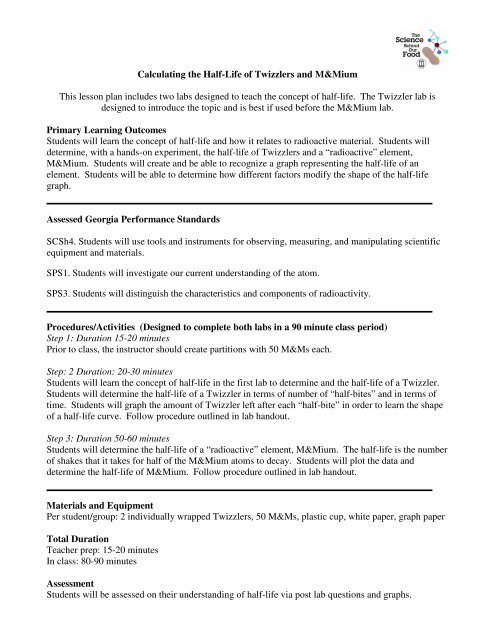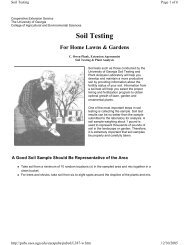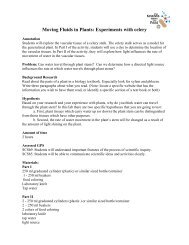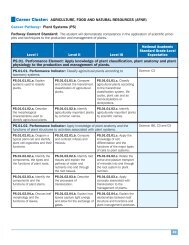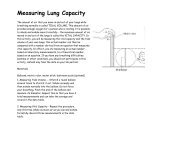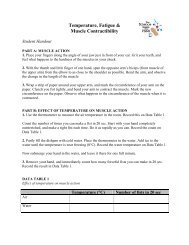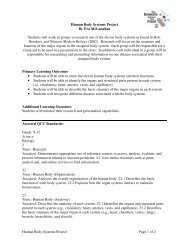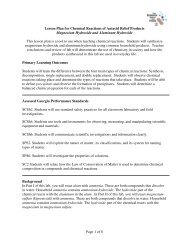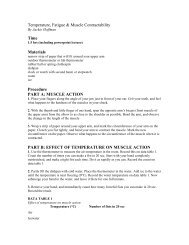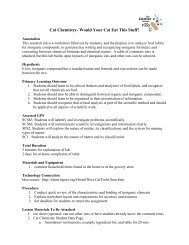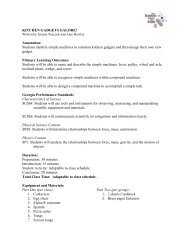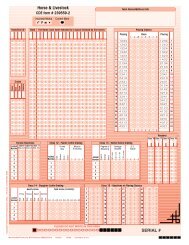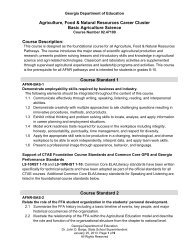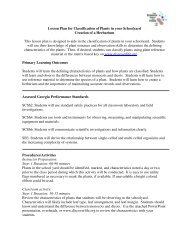Calculating the Half-Life of Twizzlers and M&Mium This lesson plan ...
Calculating the Half-Life of Twizzlers and M&Mium This lesson plan ...
Calculating the Half-Life of Twizzlers and M&Mium This lesson plan ...
- No tags were found...
You also want an ePaper? Increase the reach of your titles
YUMPU automatically turns print PDFs into web optimized ePapers that Google loves.
<strong>Calculating</strong> <strong>the</strong> <strong>Half</strong>-<strong>Life</strong> <strong>of</strong> <strong>Twizzlers</strong> <strong>and</strong> M&<strong>Mium</strong><strong>This</strong> <strong>lesson</strong> <strong>plan</strong> includes two labs designed to teach <strong>the</strong> concept <strong>of</strong> half-life. The Twizzler lab isdesigned to introduce <strong>the</strong> topic <strong>and</strong> is best if used before <strong>the</strong> M&<strong>Mium</strong> lab.Primary Learning OutcomesStudents will learn <strong>the</strong> concept <strong>of</strong> half-life <strong>and</strong> how it relates to radioactive material. Students willdetermine, with a h<strong>and</strong>s-on experiment, <strong>the</strong> half-life <strong>of</strong> <strong>Twizzlers</strong> <strong>and</strong> a “radioactive” element,M&<strong>Mium</strong>. Students will create <strong>and</strong> be able to recognize a graph representing <strong>the</strong> half-life <strong>of</strong> anelement. Students will be able to determine how different factors modify <strong>the</strong> shape <strong>of</strong> <strong>the</strong> half-lifegraph.Assessed Georgia Performance St<strong>and</strong>ardsSCSh4. Students will use tools <strong>and</strong> instruments for observing, measuring, <strong>and</strong> manipulating scientificequipment <strong>and</strong> materials.SPS1. Students will investigate our current underst<strong>and</strong>ing <strong>of</strong> <strong>the</strong> atom.SPS3. Students will distinguish <strong>the</strong> characteristics <strong>and</strong> components <strong>of</strong> radioactivity.Procedures/Activities (Designed to complete both labs in a 90 minute class period)Step 1: Duration 15-20 minutesPrior to class, <strong>the</strong> instructor should create partitions with 50 M&Ms each.Step: 2 Duration: 20-30 minutesStudents will learn <strong>the</strong> concept <strong>of</strong> half-life in <strong>the</strong> first lab to determine <strong>and</strong> <strong>the</strong> half-life <strong>of</strong> a Twizzler.Students will determine <strong>the</strong> half-life <strong>of</strong> a Twizzler in terms <strong>of</strong> number <strong>of</strong> “half-bites” <strong>and</strong> in terms <strong>of</strong>time. Students will graph <strong>the</strong> amount <strong>of</strong> Twizzler left after each “half-bite” in order to learn <strong>the</strong> shape<strong>of</strong> a half-life curve. Follow procedure outlined in lab h<strong>and</strong>out.Step 3: Duration 50-60 minutesStudents will determine <strong>the</strong> half-life <strong>of</strong> a “radioactive” element, M&<strong>Mium</strong>. The half-life is <strong>the</strong> number<strong>of</strong> shakes that it takes for half <strong>of</strong> <strong>the</strong> M&<strong>Mium</strong> atoms to decay. Students will plot <strong>the</strong> data <strong>and</strong>determine <strong>the</strong> half-life <strong>of</strong> M&<strong>Mium</strong>. Follow procedure outlined in lab h<strong>and</strong>out.Materials <strong>and</strong> EquipmentPer student/group: 2 individually wrapped <strong>Twizzlers</strong>, 50 M&Ms, plastic cup, white paper, graph paperTotal DurationTeacher prep: 15-20 minutesIn class: 80-90 minutesAssessmentStudents will be assessed on <strong>the</strong>ir underst<strong>and</strong>ing <strong>of</strong> half-life via post lab questions <strong>and</strong> graphs.
<strong>Half</strong>-life: Determining <strong>and</strong> Graphing <strong>the</strong> <strong>Half</strong>-life <strong>of</strong> a TwizzlerBackground: You should know <strong>the</strong> term “half-life” <strong>and</strong> know how it is related to radioactiveelements. The half-life <strong>of</strong> a radioactive element is <strong>the</strong> time it takes for half <strong>of</strong> its atoms to decay intosomething else. For example, iodine-125 (I-125) has a half-life <strong>of</strong> about 60 days; <strong>the</strong>refore, in 60 days,1g <strong>of</strong> I-125 will turn into half a gram <strong>of</strong> iodine-125 <strong>and</strong> half a gram <strong>of</strong> something else (<strong>the</strong> radioactivedecay products <strong>of</strong> radium). After ano<strong>the</strong>r 60 days have elapsed, only a ¼ <strong>of</strong> <strong>the</strong> original 1g <strong>of</strong> I-125will remain.Purpose: To determine <strong>the</strong> half-life <strong>of</strong> a Twizzler <strong>and</strong> graph <strong>the</strong> results.Materials:2 <strong>Twizzlers</strong> (1 for Part I <strong>and</strong> 1 for Part II)pencil/pen2 sheets <strong>of</strong> graph paperProcedure: Part I: Amount <strong>of</strong> Twizzler vs. Bites1. Hold original Twizzler vertically against <strong>the</strong> 'y' axis with one end at <strong>the</strong> origin. Mark <strong>the</strong>"length". <strong>This</strong> represents <strong>the</strong> beginning amount.2. Wait for fur<strong>the</strong>r instructions to “Take a ½ bite!” You must eat HALF (<strong>and</strong> only half) <strong>the</strong> length<strong>of</strong> <strong>the</strong> Twizzler.3. Repeat step 1, holding <strong>the</strong> Twizzler a unit from <strong>the</strong> origin. Mark <strong>the</strong> new length (this is your ycoordinate).4. Repeat steps 2 <strong>and</strong> 3 with <strong>the</strong> class until <strong>the</strong> instructor tells you to stop.5. Draw a smooth “Best-Fit” line on your graph.Procedure: Part II: Amount <strong>of</strong> Twizzler vs. Time1. <strong>This</strong> time <strong>the</strong> procedure in Part I will be repeated except <strong>the</strong> instructor will tell you to take abite every 45 seconds <strong>and</strong> record your data!Conclusions <strong>and</strong> Analysis:1. Did <strong>the</strong> Twizzler ever completely disappear? Explain.2. What was <strong>the</strong> half-life <strong>of</strong> <strong>the</strong> Twizzler in Part II?3. If you had started with a GIANT Twizzler (2X <strong>the</strong> normal size) how would this have affected<strong>the</strong> shape <strong>of</strong> <strong>the</strong> graph? Explain.Describe <strong>the</strong> effect on <strong>the</strong> graph if you took a bite every 90 seconds.
<strong>Half</strong>-life: Determining <strong>and</strong> Graphing <strong>the</strong> <strong>Half</strong>-life <strong>of</strong> M&<strong>Mium</strong>Background: You should know <strong>the</strong> term “half-life” <strong>and</strong> know how it is related to radioactiveelements. The half-life <strong>of</strong> a radioactive element is <strong>the</strong> time it takes for half <strong>of</strong> its atoms to decay intosomething else. For example, iodine-125 (I-125) has a half-life <strong>of</strong> about 60 days; <strong>the</strong>refore, in 60 days,1g <strong>of</strong> I-125 will turn into half a gram <strong>of</strong> iodine-125 <strong>and</strong> half a gram <strong>of</strong> something else (<strong>the</strong> radioactivedecay products <strong>of</strong> radium). After ano<strong>the</strong>r 60 days have elapsed, only a ¼ <strong>of</strong> <strong>the</strong> original 1g <strong>of</strong> I-125will remain.Purpose: To determine <strong>the</strong> half-life <strong>of</strong> <strong>the</strong> element M&<strong>Mium</strong>.Materials:Bag <strong>of</strong> M&<strong>Mium</strong> Isotopes**Radioactive members <strong>of</strong> this isotope family are easily distinguished via a bold m on<strong>the</strong> front surface <strong>of</strong> <strong>the</strong> atom.**1 plastic cuppencil/penwhite piece <strong>of</strong> paper1 sheet <strong>of</strong> graph paperProcedure:1. Count <strong>the</strong> number <strong>of</strong> M&<strong>Mium</strong> atoms as you place <strong>the</strong>m in <strong>the</strong> cup. Record <strong>the</strong> total number <strong>of</strong>radioactive atoms you start with in your data table (on <strong>the</strong> back <strong>of</strong> your graph paper).2. Cover <strong>and</strong> shake/rattle <strong>the</strong> cup.3. Carefully pour your atoms onto your white paper. You will see that several <strong>of</strong> <strong>the</strong> previouslyradioactive atoms in <strong>the</strong> group have decayed, <strong>and</strong> <strong>the</strong> m is no longer visible. <strong>This</strong> means that<strong>the</strong>y are now considered "safe" <strong>and</strong>, since <strong>the</strong>y are no longer radioactive, may actually be eatenwithout fear <strong>of</strong> any harm to you! Please do so, <strong>and</strong> as you remove <strong>the</strong> edible atoms, count<strong>the</strong>m so you may determine <strong>the</strong> number <strong>of</strong> atoms that have decayed in that particularshake. (NOTE: You should not eat any <strong>of</strong> <strong>the</strong> decayed M&<strong>Mium</strong> atoms until you are onyour 3 rd trial)4. Now you need to continue this pattern until no more radioactive members remain. Rememberto record <strong>the</strong> number <strong>of</strong> decayed atoms after each shake!Analysis:Using <strong>the</strong> graph paper provided, construct a graph <strong>of</strong> N (Number <strong>of</strong> decayed atoms) as a function <strong>of</strong><strong>the</strong> number <strong>of</strong> shakes. Use <strong>the</strong> average <strong>of</strong> <strong>the</strong> 3 trials to construct this graph. (Remember to label yourx-axis, y-axis, <strong>and</strong> indicate a title for your graph.)Conclusions:1. Calculate <strong>the</strong> half-life <strong>of</strong> M&<strong>Mium</strong>? (i.e., What number <strong>of</strong> shakes are necessary to reduce <strong>the</strong>radioactive members to one-half?)
M&<strong>Mium</strong> Data TableShake #Trial 1# DecayedTrial 2# DecayedTrial 3# DecayedTotalAverage
___________________________________________________________________________________________________


